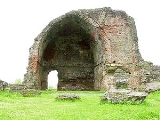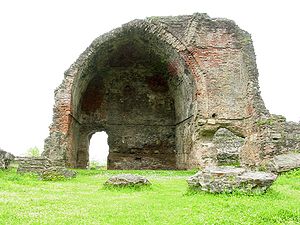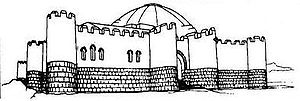
Geguti
Encyclopedia

Georgia (country)
Georgia is a sovereign state in the Caucasus region of Eurasia. Located at the crossroads of Western Asia and Eastern Europe, it is bounded to the west by the Black Sea, to the north by Russia, to the southwest by Turkey, to the south by Armenia, and to the southeast by Azerbaijan. The capital of...
medieval royal palace, now in ruins, at the omonymous village, 7 km south of the city of Kutaisi
Kutaisi
Kutaisi is Georgia's second largest city and the capital of the western region of Imereti. It is 221 km to the west of Tbilisi.-Geography:...
, Georgia
Georgia (country)
Georgia is a sovereign state in the Caucasus region of Eurasia. Located at the crossroads of Western Asia and Eastern Europe, it is bounded to the west by the Black Sea, to the north by Russia, to the southwest by Turkey, to the south by Armenia, and to the southeast by Azerbaijan. The capital of...
.
The ruins of the Geguti palace complex occupy the area of over 2,000 m2 along the Rioni River
Rioni River
The Rioni or Rion River is the main river of western Georgia. It originates in the Caucasus Mountains, in the region of Racha and flows west to the Black Sea, entering it north of the city of Poti...
. An extensive fieldwork between 1953 and 1956 allowed the specialists to stratify the principal archaeological layers and reconstruct the architectural form and decoration of the medieval edifices bulk of which dates to the 12th century, the period when the first written mention of Geguti appears in the Georgian Chronicle. The earliest structure – a plain, one-room building with a large fireplace – dates back to the 8th/9th century. A principal part of the royal complex, commissioned by King George III of Georgia
George III of Georgia
Giorgi III , of the Bagrationi dynasty, was king of Georgia from 1156 to 1184. His reign, and that of Tamar, are seen as the 'golden age' of Georgian history, the era of empire, diplomatic success, military triumphs, great learning, cultural, spiritual, and artistic flowering.-Life:He succeeded on...
(r. 1156-1184), is a four-tier brick edifice built onto a three-metre high stone plinth, with its spacious, cruciform central hall surmounted by a dome 14 m in diameter resting on squinches. The entire building is walled and fortified with massive pillars. Westerly located additional structures and a palace church are of a later period, dating to the 13th/14th century.
The importance of the ruins of the Geguti palace is emphasized by its largely secular nature as most of the surviving monuments of medieval Georgian architecture are churches and monasteries. Records of medieval secular patronage (basically palaces with extensive decorative cycles) exist in the Georgian written sources, although only the shells of castles and the ruins of Geguti survive to testify the extent of the work produced.

Golden Age
The term Golden Age comes from Greek mythology and legend and refers to the first in a sequence of four or five Ages of Man, in which the Golden Age is first, followed in sequence, by the Silver, Bronze, and Iron Ages, and then the present, a period of decline...
". Although the Georgian court was quite mobile, the establishment of a royal palace of this scale near the kingdom’s second capital and a major cultural center can be understood as the desire to establish a more settled, regal court, and royal bureaucracy which, indeed, reached its climax under the queen regnant
Queen regnant
A queen regnant is a female monarch who reigns in her own right, in contrast to a queen consort, who is the wife of a reigning king. An empress regnant is a female monarch who reigns in her own right over an empire....
Tamar
Tamar of Georgia
Tamar , of the Bagrationi dynasty, was Queen Regnant of Georgia from 1184 to 1213. Tamar presided over the "Golden age" of the medieval Georgian monarchy...
(r. 1184-1213).
The Geguti palace frequently features in the Georgian annals as a beloved place of rest of the Georgian royalty. In the reign of Tamar, it was the place where her former husband, Prince Yuri Bogolyubsky
Yuri Bogolyubsky
Yury Bogolyubsky , known as Giorgi Rusi in Georgia, was a Rus' prince of Novgorod . Married to Queen Regnant Tamar of Georgia, he was a consort of the Kingdom of Georgia from 1185 until being expelled from the country in 1188....
, was crowned by the rebellious nobles during an abortive coup against the queen in 1191.

